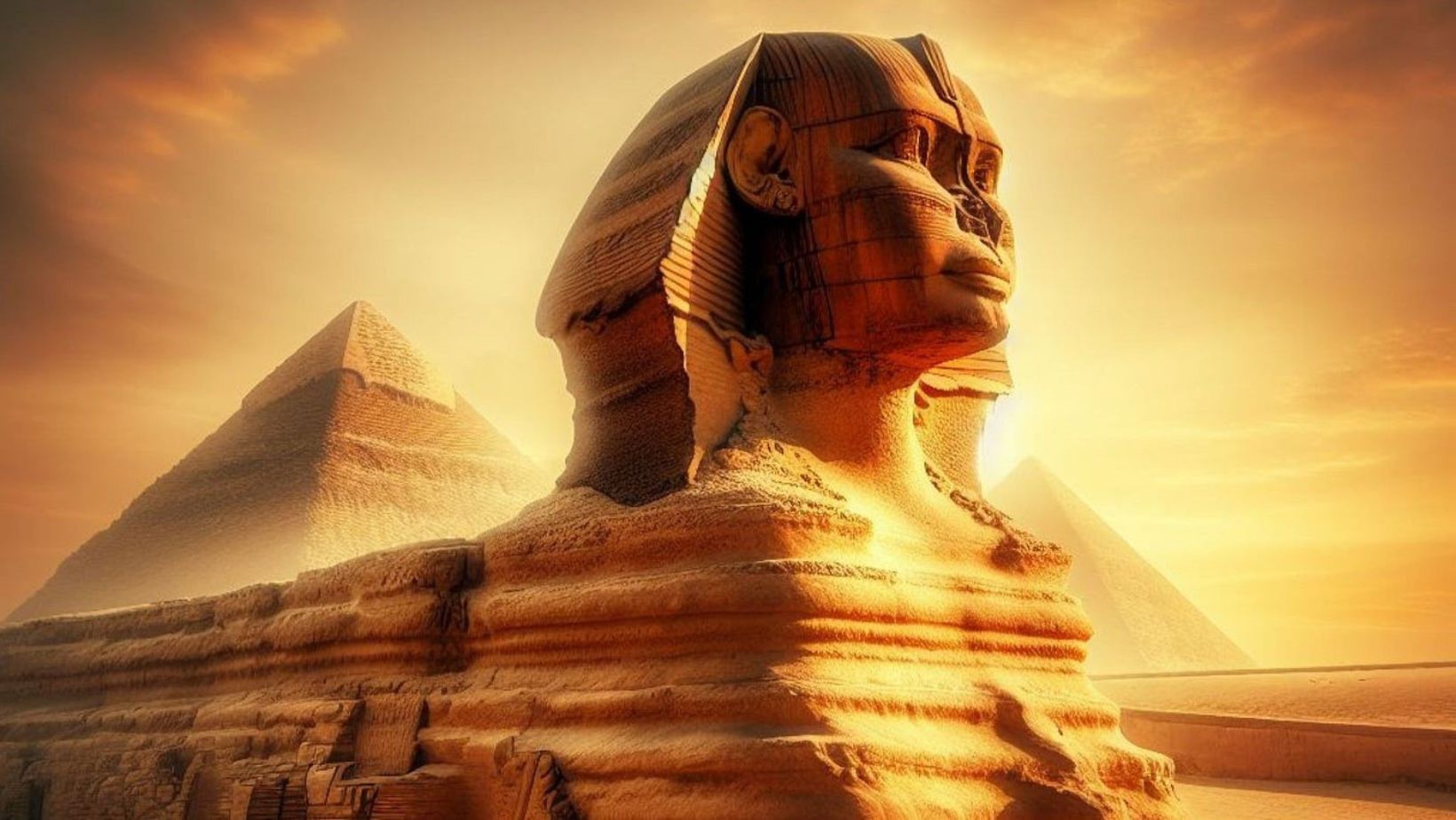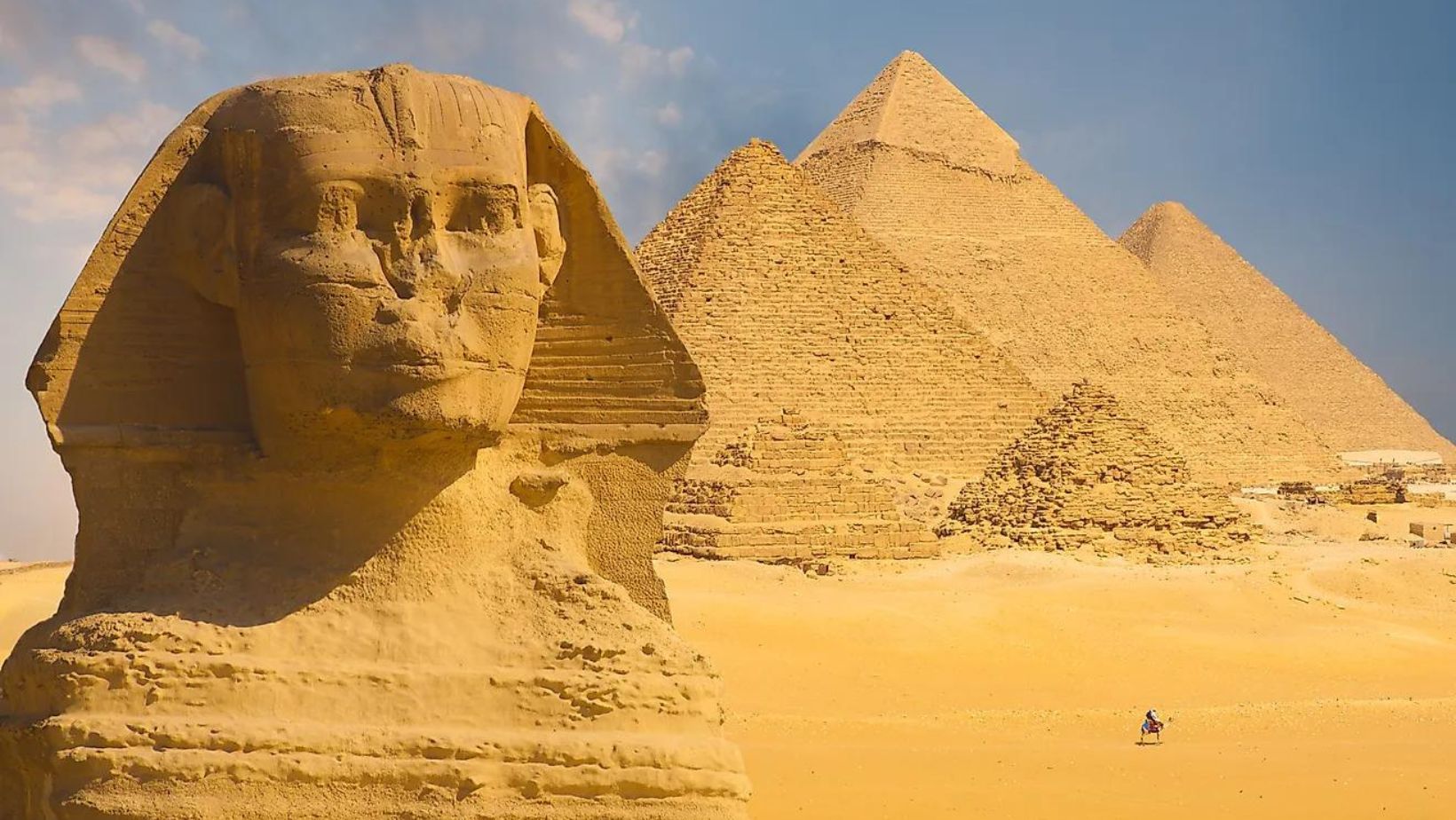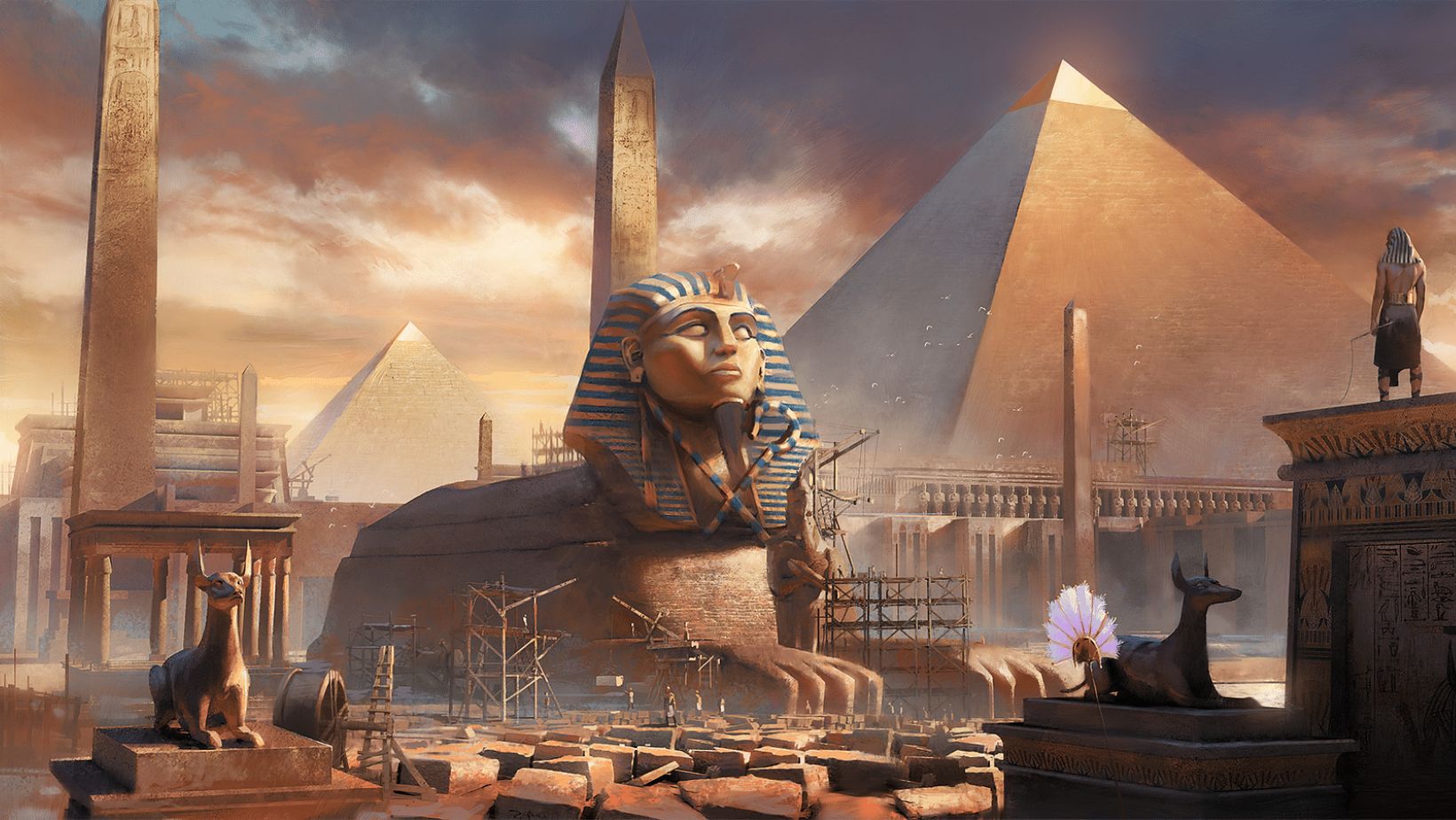The Sphinx and the Pyramids stand as iconic symbols of ancient Egypt. The Great Sphinx, with its lion body and human head, gazes over the Giza plateau, guarding the Pyramids of Khufu, Khafre, and Menkaure. Together, these monumental structures showcase the architectural prowess and cultural richness of a civilization that thrived thousands of years ago. Their connection goes beyond mere proximity; it reflects deep religious beliefs and the quest for immortality. Exploring this bond reveals insights into the ancient Egyptians’ understanding of life, death, and the cosmos, inviting us to unravel the mysteries of this fascinating era.
Historical Context
The Old Kingdom period in Egypt, often called the “Age of the Pyramids,” lasted from around 2686 to 2181 BCE. This era marked the zenith of pyramid construction and the centralization of political power. The Pharaohs of this period believed in the afterlife and constructed monumental tombs to ensure their immortality. These pyramids served as elaborate burial sites, showcasing their wealth and religious devotion.
Key figures in this remarkable age include Pharaoh Khufu, who commissioned the Great Pyramid, the largest of the three. His successor, Pharaoh Khafre, constructed the second pyramid and is often associated with the Great Sphinx. The Sphinx itself is believed to represent Khafre, embodying his power and divine protection. Additionally, Pharaoh Menkaure, the last of the Giza pyramid builders, contributed to this architectural legacy. These leaders played crucial roles in shaping ancient Egypt’s cultural and religious landscape, cementing their places in history through these monumental constructions.
Architectural Features of the Sphinx

The Great Sphinx of Giza is an iconic symbol of ancient Egypt, renowned for its massive size and unique design. It measures about 73 meters long and 20 meters high, making it one of the largest sculptures in the world. The Sphinx features a lion’s body, representing strength, and a human head, which is thought to depict Pharaoh Khafre. This combination symbolizes the fusion of human intellect and animal power, reflecting the divine authority of the Pharaoh.
Constructed primarily from limestone, the Sphinx was carved directly from the Giza plateau, showcasing the ancient Egyptians’ impressive skills in stoneworking. The original casing stones, made of fine Tura limestone, once gleamed brilliantly in the sunlight, adding to its grandeur. Over time, many of these casing stones have eroded or been removed, exposing the underlying core structure. The Sphinx also features detailed facial features, including a well-defined nose and a serene expression, which were meticulously sculpted to convey a sense of permanence and authority. Overall, the architectural features of the Sphinx reflect the ingenuity and artistic capabilities of ancient Egyptian builders.
The Great Pyramid of Giza
The Great Pyramid of Giza is one of the most remarkable architectural achievements in human history. Built during the Fourth Dynasty of the Old Kingdom, it was constructed around 2580–2560 BCE for Pharaoh Khufu. The pyramid was originally 146.6 meters tall, making it the tallest man-made structure in the world for over 3,800 years. Its construction involved approximately 2.3 million blocks of limestone and granite, weighing between 2.5 and 15 tons each.
The Great Pyramid served as a monumental tomb for Pharaoh Khufu, reflecting his status and power. It was part of a larger complex that included smaller pyramids for queens, temples, and other structures. Khufu’s pyramid was designed to facilitate his journey to the afterlife, with elaborate burial chambers and corridors. The interior consists of the King’s Chamber, Queen’s Chamber, and the Grand Gallery, all engineered with remarkable precision.
As a symbol of ancient Egypt’s engineering prowess, the Great Pyramid remains a source of fascination. It demonstrates the Egyptians’ advanced knowledge of mathematics and astronomy. Today, it stands as a testament to the enduring legacy of Pharaoh Khufu and the civilization that built it.
The Relationship Between the Sphinx and the Pyramids

The Great Sphinx of Giza is closely linked to the Pyramids, both geographically and symbolically. Positioned near the Pyramids of Giza, the Sphinx stands at the entrance to the Giza plateau. Its location aligns with the pyramids, creating a grand complex that reflects the ancient Egyptians’ architectural vision. This alignment signifies the Sphinx’s role as a guardian of these monumental tombs.
The Sphinx is often seen as a protective figure, watching over the pyramids and their associated structures. With the body of a lion and the head of a pharaoh, it symbolizes strength and wisdom. Ancient Egyptians believed that the Sphinx could safeguard the deceased pharaohs in their journey to the afterlife. This connection emphasizes the significance of both structures in ancient Egyptian culture.
Moreover, the Sphinx and the pyramids share a common purpose: they are both part of the elaborate funerary practices aimed at ensuring a successful transition to the afterlife. Their close proximity and design demonstrate the importance of protection and continuity in the ancient Egyptian belief system. Together, they embody the civilization’s religious and cultural values, forming an enduring legacy that continues to captivate historians and tourists alike.
Symbolism and Cultural Significance
The Sphinx and the Pyramids hold deep symbolism in ancient Egyptian culture. The Sphinx, with its lion’s body and human head, represents strength, wisdom, and protection. It embodies the pharaoh’s power and their divine connection to the gods. This symbolism aligns closely with the purpose of the Pyramids, which served as monumental tombs for pharaohs, ensuring their safe passage into the afterlife.
Both structures are rich in religious and mythological meanings. The Pyramids were designed to facilitate the pharaoh’s resurrection and ascension to the heavens. They were seen as a means to bridge the earthly and the divine. Meanwhile, the Sphinx was believed to guard the tombs, serving as a protector against any threats.
Additionally, the Sphinx is linked to the sun god Ra. This connection enhances its significance, as ancient Egyptians viewed pharaohs as intermediaries between the gods and the people. Together, the Sphinx and the Pyramids symbolize the unification of earthly authority and divine power. They reflect the ancient Egyptians’ beliefs in the afterlife, protection, and the enduring nature of their civilization.
Theories About the Sphinx’s Purpose
The purpose of the Sphinx has intrigued historians and archaeologists for centuries. One prominent theory suggests that it served as a guardian for the nearby Pyramids. This aligns with the Sphinx’s protective symbolism, as it is positioned to oversee the tombs of the pharaohs. Another theory posits that the Sphinx was associated with solar worship.
Many scholars believe the Sphinx was built to honor the sun god, Ra. Its eastward gaze aligns with the sunrise, suggesting a connection to the sun’s life-giving power. This connection highlights the importance of solar worship in ancient Egyptian culture. Additionally, the Sphinx may symbolize royal power.
The pharaoh, viewed as a divine ruler, embodied the qualities of both the lion and the human. The Sphinx could represent the pharaoh’s strength and wisdom. Some theories also propose that the Sphinx was part of a larger complex of temples dedicated to solar deities. These interpretations underscore the Sphinx’s multifaceted significance in ancient Egyptian society, blending themes of protection, divinity, and royal authority. The debate continues, but the Sphinx remains a powerful symbol of ancient Egypt’s rich spiritual heritage.
Archaeological Discoveries and Excavations
Archaeological discoveries around the Sphinx and the Pyramids have unveiled significant insights into ancient Egyptian culture. Notable findings include the uncovering of a series of temples and structures near the Sphinx. These discoveries suggest a ceremonial complex that may have been integral to royal rituals. Excavations have also revealed tools and artifacts, offering clues about the construction techniques used during the Old Kingdom.
In addition, excavations have led to the identification of burial chambers connected to the Pyramids. These chambers contain offerings and items intended for the afterlife. Such findings deepen our understanding of burial practices and the importance of the Sphinx as a guardian of these sacred sites. The alignment of the Sphinx with the Pyramids suggests a deliberate architectural plan, emphasizing their interconnectedness.
Furthermore, studies of the surrounding landscape have shown how the Sphinx was part of a larger religious and cultural framework. Each discovery reinforces the notion that the Sphinx and the Pyramids were not isolated structures. Instead, they were key components of a vast, intertwined spiritual narrative in ancient Egypt. These archaeological endeavors continue to shape our comprehension of the profound connections between these iconic monuments.
Preservation Efforts
Preserving the Sphinx and the Pyramids presents significant challenges. Natural erosion, pollution, and tourism all threaten these ancient monuments. Sandstorms and environmental changes can wear down the stone, while urban development nearby adds additional pressure. Without effective preservation, these structures may suffer irreversible damage.
Ongoing restoration initiatives aim to address these issues. Experts are using advanced technologies to monitor the condition of both the Sphinx and the Pyramids. These efforts include structural reinforcement and the application of protective coatings to prevent deterioration. Regular cleaning is also vital to remove dust and pollutants that can harm the stone.
International collaborations play a crucial role in these preservation efforts. Organizations like UNESCO are involved in promoting awareness and funding for restoration projects. Such initiatives not only help maintain the monuments but also educate the public about their significance. By investing in these preservation efforts, we can ensure that the Sphinx and the Pyramids continue to stand as testaments to ancient Egyptian culture for future generations.
Modern Interpretations and Legacy

The Sphinx and the Pyramids continue to influence contemporary culture significantly. Their iconic images appear in various forms of art, from paintings to digital media. Artists draw inspiration from these ancient structures, blending them into modern themes and narratives. This fusion highlights the timeless appeal of these monuments.
In literature, the Sphinx and Pyramids often symbolize mystery and enigma. They inspire countless stories, poems, and novels that explore ancient Egyptian themes. These structures serve as backdrops for tales of adventure, exploration, and the quest for knowledge. Such narratives keep the allure of ancient Egypt alive in the modern imagination.
Tourism also plays a vital role in their legacy. Millions of visitors flock to Giza each year to witness these magnificent structures firsthand. This interest drives economic growth in the region and fosters a greater appreciation for Egypt’s rich history. Educational programs at the site further enhance visitors’ understanding of ancient civilization.
Overall, the Sphinx and Pyramids remain powerful symbols of human achievement. Their legacy continues to shape art, literature, and tourism, ensuring their place in global culture for generations to come.
Conclusion: Sphinx and the Pyramids
In summary, the Sphinx and the Pyramids are iconic symbols of ancient Egypt, showcasing remarkable architectural achievements and deep cultural significance. Their historical context reveals the powerful rulers and societal beliefs of the Old Kingdom. The physical connection between these structures emphasizes their roles as guardians and representations of divine power. Archaeological discoveries continue to shed light on their mysteries, while preservation efforts ensure their survival for future generations. Ultimately, the lasting significance of the Sphinx and the Pyramids lies in their ability to inspire curiosity and admiration, reminding us of humanity’s enduring quest for knowledge and meaning.
FAQs
What is the age of the Sphinx and the Pyramids?
The Great Sphinx is believed to date back to around 2500 BC, during the reign of Pharaoh Khafre, while the Pyramids of Giza were built during the Fourth Dynasty of the Old Kingdom, around the same period.
Are there any theories about who built the Sphinx?
While many believe the Sphinx was commissioned by Pharaoh Khafre, some theories suggest it could have been constructed by earlier dynasties or even earlier than previously thought.
What materials were used to construct the Sphinx and the Pyramids?
The Sphinx is primarily made of limestone, sourced from the Giza Plateau, while the Pyramids were constructed using large limestone blocks and granite. The exact methods of transport and assembly remain subjects of research and debate.
Can visitors access the Sphinx and the Pyramids?
Yes, visitors can explore the Giza plateau, which includes access to the Pyramids and the Sphinx. However, specific areas may have restrictions to ensure preservation and safety.
What cultural significance do the Sphinx and the Pyramids hold today?
The Sphinx and the Pyramids continue to symbolize ancient Egyptian civilization and are significant in studies of history, architecture, and archaeology. They also attract millions of tourists, serving as cultural and historical landmarks.
